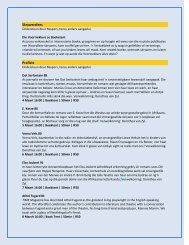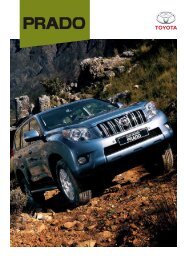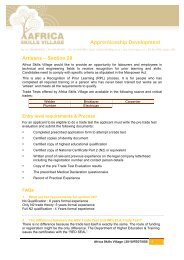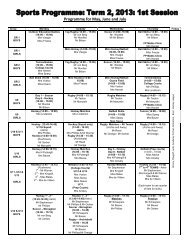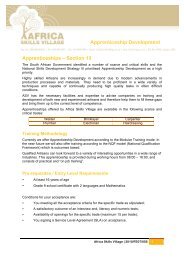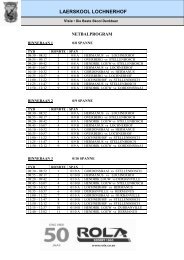Create successful ePaper yourself
Turn your PDF publications into a flip-book with our unique Google optimized e-Paper software.
HISTORY OF CAPE WINES<br />
EARLY TIMES<br />
The first <strong>South</strong> <strong>Africa</strong>n vineyard was planted<br />
by Commander Jan van Riebeeck in 1655<br />
and, on February 2, 1659 he recorded this<br />
famous phrase in his diary: “Today, praise<br />
be to God, wine was pressed for the first<br />
time from Cape grapes,”<br />
Under Van Riebeeck’s successor, Simon<br />
van der Stel, viticulture flourished – he<br />
developed Groot Constantia into a model<br />
farm. In 1688, the French Huguenots arrived<br />
in <strong>South</strong> <strong>Africa</strong>. Both they and the German<br />
settlers later made a valuable contribution<br />
to the development of a <strong>South</strong> <strong>Africa</strong>n<br />
wine culture. During the 18th century,<br />
Constantia’s famous dessert wines earned<br />
international recognition for Cape wines,<br />
however this was followed by a period<br />
of decline. Protective tariffs in Britain<br />
were abolished and by 1880, phylloxera<br />
– a plague that destroys vine roots – had<br />
devastated <strong>South</strong> <strong>Africa</strong>n vineyards. After<br />
the discovery that American rootstock was<br />
resistant to phylloxera, local vineyards were<br />
replanted with grafted rootstock.<br />
Attempts to counteract overproduction and<br />
low prices led to the establishment of KWV<br />
(Co-operative Winegrowers Association) in<br />
1918. This was followed by the introduction<br />
of minimum prices and production quotas<br />
to ensure a stable market. Since then,<br />
the industry has made significant strides<br />
forward with the application of the most<br />
scientific viticultural practices and the<br />
use of the most modern cellar equipment.<br />
Continued research into varieties, soil types<br />
and fermentation keeps it at the forefront<br />
of developments.<br />
The introduction in 1957 of cold<br />
fermentation resulted in a better bouquet<br />
and improved quality of white wines. It also<br />
increased the popularity of semi-sweet<br />
wines. In 1973, a comprehensive system of<br />
control was introduced for ’wines of origin’.<br />
Thirteen areas of origin were designated<br />
and limitations placed on the use of the<br />
term ‘estate’, vintage dates and grape<br />
variety designations. Local wine industry<br />
regulations were brought in line with those<br />
in Europe, contributing to varietal and<br />
classic wines becoming more popular.<br />
In 1975, the first auction of rare Cape wines<br />
took place at Nederburg in Paarl, near Cape<br />
Town. This was to become the showpiece<br />
of the <strong>South</strong> <strong>Africa</strong>n wine industry.<br />
A NEW CENTURY<br />
By the end of the 20th century, KWV had<br />
been transformed and new groupings<br />
had formed as other co-operative wine<br />
cellars converted into companies and<br />
restructured to suit changing local and<br />
global market conditions. These changes<br />
would positively influence the wine<br />
industry in the 21st century.<br />
KWV changed from a co-operative to a<br />
company in December 1997. After lengthy<br />
negotiations between the Minister of<br />
Agriculture and KWV, the Wine Industry<br />
Trust was established in February 1999 by<br />
these two parties. The aim was to fund and<br />
manage generic promotion and research<br />
for the <strong>South</strong> <strong>Africa</strong>n wine industry, to<br />
assist with the establishment of new<br />
farmers from previously disadvantaged<br />
groups, and to promote the development<br />
of farm worker communities.<br />
In 2001, Stellenbosch Farmers’ Winery<br />
and Distillers Corporation merged to<br />
form a new liquor giant, Distell. Today,<br />
Distell’s brands are sold in over 100<br />
countries. Wines of <strong>South</strong> <strong>Africa</strong> (WOSA),<br />
an independent, not-for-profit company<br />
formed in 2000, represents all <strong>South</strong><br />
<strong>Africa</strong>n wine exporters and promotes their<br />
wines abroad, with the aim of building<br />
Brand <strong>South</strong> <strong>Africa</strong>. In 2004, Stellenbosch<br />
Vineyards and Vinfruco merged to form<br />
Omnia Wines – relaunched in 2006 as The<br />
Company of Wine People – a major player<br />
involved in the process from vineyard to<br />
consumer, locally and internationally.<br />
8 9<br />
CAPE WINE INDUSTRY:<br />
FACTS AND FIGURES<br />
The total area under bearing vines (wine<br />
and table grapes) is approximately 115 418<br />
hectares (excluding sultana), ranking <strong>South</strong><br />
<strong>Africa</strong> 14th in the world. This represents 1.7%<br />
of global area under vines. The average<br />
annual wine grape crop yield is 772 litres per<br />
gross ton, the total crush averaging about<br />
1.3 million tons annually. Producing 3.5% of<br />
global production volumes, <strong>South</strong> <strong>Africa</strong><br />
ranks eighth in the world (as at end 2010).<br />
Of the 3 527 primary grape producers in<br />
the country, 41.4% produce 100 tons or less<br />
and 36.1% between 101 and 500 tons during<br />
2011. In 2011, a total of 582 cellars produced<br />
wine in <strong>South</strong> <strong>Africa</strong>. Of the 52 producer<br />
cellars, 34 crushed more than 10 000 tons<br />
and of the 505 private cellars, 453 crushed<br />
less than 1 000 tons.<br />
The wine industry directly and indirectly<br />
supports some 275 606 people and<br />
contributes about R26.2 billion to the<br />
country’s GDP (including tourism), with<br />
about R14.2 billion remaining in the Western<br />
Cape to benefit its residents. Annually, an<br />
estimated R4.3 billion (turnover) is also<br />
generated indirectly through tourism in the<br />
Winelands (2009 figures).





